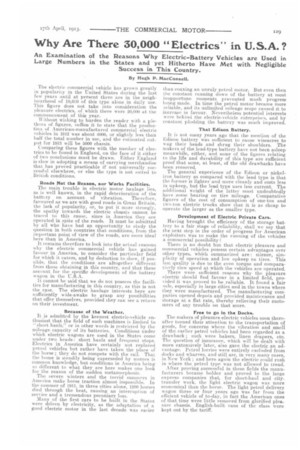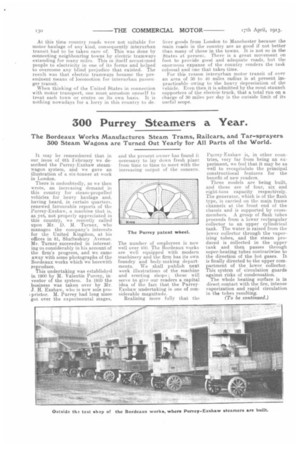Why Are• There 30,000 "Electrics" in U.S.A. ?
Page 5

Page 6

If you've noticed an error in this article please click here to report it so we can fix it.
An Examination of the Reasons Why Electric-Battery Vehicles are Used in Large Numbers in the States and yet Hitherto Have Met with Negligible Success in This Country.
By Hugh P. MacConnell.
The electric commercial vehicle has grown greatly in popularity in the United States during the last few years until at present there are in the neighbourhood of 10,000 of this type alone in daily use. This figure does not take into consideration the pleasure electrics, of which there were 20,000 at the commencement of thin year
Without wishing to burden the reader with a plethora of figures, suffice it to state that the production. of Americanenanufaatured commercial electric vehicles in 1912 was about 4000, or slightly less than half the total number in use, and the estimated output for 1913 will be 5000 chassis.
Comparing these figures with the number of electries to be found in England, on the face of it either of two conclusions must be drawn. Either England is slow in adopting a mean e of carrying merchandise that has proved practicable if not universally successful elsewhere, or else the type is not suited to British conditions.
Roads Not the Reason, nor Works Facilities.
The main trouble in electric motor haulage lies, as is well known, in the rapid deterioration of the battery on account of vibration. Therefore, favoured as we are with good roads in Great Britain, the lack of popularity, or, to put it more strongly, the apathy towards the electric chaesie cannot be traced to this cause, since in America they are operated in spite of the roads. It must be admitted by all who have had an opportunity to study the question in both countries that conditions, from the important point of view of the roads, are more ideal here than in America.
It remains therefore to look into the actual reasons why the electric commercial vehicle has gained favour in America, to consider the particular field for which it caters, and by deduction to show, if possible, that the conditions are altogether different from those obtaining in this country, and that these account for the specific development of the battery wagon in the U.S.A.
It cannot be said that we do not possess the facilities for manufacturing in this country, as this is not the case. The electric haulage interests here are sufficiently wide-awake to grasp any possibilities that offer themselves, provided they can see a return on their investment.
Because of the Weather.
It is admitted by the keenest electric-vehicle enthusiast that the field of such machines is limited to "short hauls," or in other words is restricted by the mileage capacity of its batteries. Conditions under which electric wagons are used in the States come under two heads: short hauls and frequent stops.. Electrics in America have certainly not replaced petrol vehicles but rather have taken the place of the horse ; they do not compete with the rail. That the horee is steadily being superseded by motors is common knowledge, but conditions in America being so different to what they are here makes one look for the reason of the sudden metamorphosis.
The severe winters and the torrid summers in America make horse traction almost impossible. In the summer of 1911, in three cities alone, 1200 horses died through the heat, causing an interruption of service and a tremendous pecuniary loss.
Many of the first cars to be built in the States were driven by electricity, as the adaptation of a good electric motor in the last decade was easier than coaxing an unruly petrol motor. But even then the constant running down of the battery at most inopportune moments prevented much progress being made. In time the petrol motor became more reliable, and its unlimited mileage scope caused it to increase in favour. Nevertheless potential interests were behind the electric-vehicle enterprises, and by constant plodding the battery was much improved.
That Edison Battery.
It is not many years ago that the mention of the Edison battery was sufficient to cause wiseacres to wag their heads and shrug their shoulders. The makers of the lead-type battery have not been asleep meanwhile, either, and some of the figures relating to the life and durability of this type are sufficient proof that some, at least, of the old drawbacks have been removed.
The general experience of the Edison or nickeliron battery as compared with the lead type is that the former is lighter and more cleanly and costs less in upkeep, but the lead type uses less current. The additional weight of the latter must undoubtedly have some bearing on tire mileage. Comparative figures of the cost of consumption of one-ton and two-ton electric trucks show that it is as cheap to operate the larger as the smaller type.
Development of Electric Private Cars.
Having brought the efficiency of the storage battery to a fair stage of reliability, shall we say that the next step in the order of progress for American exploiters was to make the running of the vehicles a commercial possibility?
There is no doubt but that electric pleasure and commercial vehicles possess certain advantages over other types, whieh summarized are : silence, simplicity of operation and low upkeep On tires. This last quality is due to the even torque and comparatively slow speed at which the vehicles are operated. There were sufficient reasons why the pleasure electric should find favour in a limited field, provided it was proved to be reliable. It found a fair sale, especially in large cities and in the towns where they were manufactured. The manufacturing companies opened depots and provided maintenance and storage at a flat rate, thereby relieving their customers of any trouble on that score.
Free to go in the Docks.
The makers of pleasure electric vehicles soon thereafter turned their attention to the transportation of goods, for concerns where the vibration and smell of the earlier petrol vehicles had been regarded as a drawback ; such were bakers, linen drapers, etc. The question of insurance, which will be dealt with more extensively later, also gave the electric an advantage. Petrol lorries were entirely excluded from docks and wharves, and still are, in very many cases, in New York ; and here again the electric could rush in where the petrol type was not allowed to tread.
.A fter proving euceessful in these fields the manufacturers became holder and proved to the large express companies that, for short-haul and citytransfer work, the light electric wagon was more economical than the horse. The light petrol delivery wagon three or four years ago was far from the efficient vehicle of to-day, in fact the American ones of that time were little removed from glorified pleasure. chassis. English-built vans of the class were kept out by the tariff.
At this time country roads were not suitable for motor haulage of any kind, consequently interurban transit had to be taken care of. This was done by connecting neighbouring towns by electric tramways extending for many miles. This in itself accustomed people to electricity in one of its forms and helped to overcome any blind prejudice that existed. The result was that electric tramways became the preeminent means of locomotion for interurban passenger transit.
When thinking of the United States in connection with motor transport, one nuist accustom oneself to treat each town or centre on its own basis. It is nothing nowadays for a lorry in this country to de
liver goods from London to Manchester because• the main roads in the country are as good if not better than many of those in the towns. It is not so in the States at present. There is a great movement on foot to provide good and adequate roads, but the enormous expanse of the country renders the task colossal and one that takes time,
For this reason interurban motor transit of over an area. of 30 to 40 miles radius is at present impracticable owing to the heavy depreciation of the vehicle. Even then it is admitted by the most staunch supporters of the electric truck, that a total run on a charge of 30 miles per day is the outside limit of its useful scope.






















